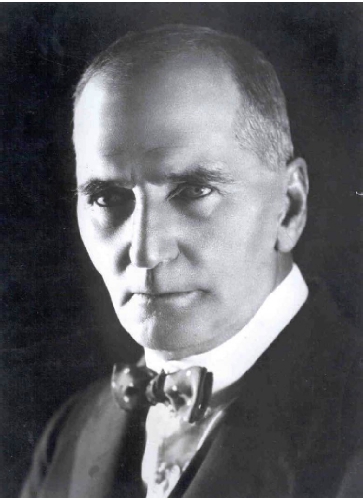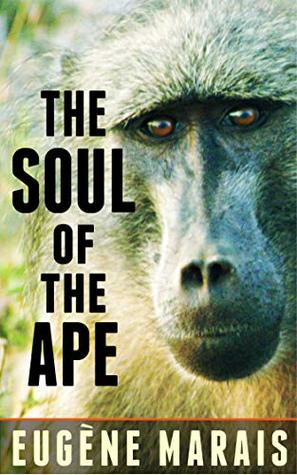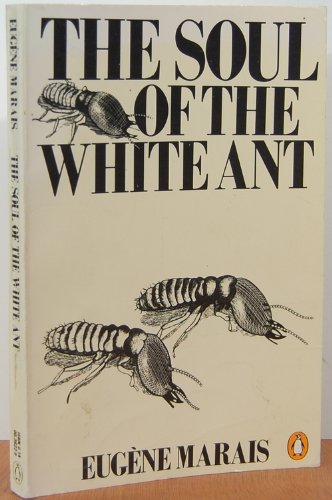Eugene Marais
Amateur naturalist extraordinare
Eugene Marais
Eugène Charles Gerard Marais (1871–1936) - Naturalist | South Africa
Eugène Nielen Marais was a South African lawyer, naturalist, poet and writer. He has been hailed as an intellectual genius and an Afrikaner hero.
Eugene Marais was a human community in the person of one man. He was a poet, an advocate, a journalist, a story-teller, a drug addict, a psychologist, a natural scientist. He embraced the pains of many, the visions of the few, and perhaps the burden was too much for one man… As a scientist he was unique, supreme in his time, yet a worker in a science then unborn. - written by Robert Ardrey in his introduction to Marais’ The Soul of the Ape.
Marais’ masterpiece, The Soul of the Ape, is the first prolonged scientific study of primates in the wild (in this case, the baboon) ever published (although the unfinished manuscript was not discovered and published until over a quarter of a century after his death).
Marais was born in Pretoria, the thirteenth and last child of Jan Christiaan Nielen Marais and Catharina Helena Cornelia van Niekerk. He attended school in Pretoria, Boshof and Paarl, and much of his early education was in English, as were his earliest poems. He matriculated at the age of sixteen.
After leaving school, he worked in Pretoria as a legal clerk and then as a journalist before becoming owner (at the age of twenty) of a newspaper called Land en Volk (Country and (the Afrikaner) People). He involved himself deeply in local politics. He began taking opiates at an early age and graduated to morphine (then considered to be non-habit forming and safe) very soon thereafter. He became addicted, and his addiction ruled his affairs and actions to a greater or lesser extent throughout his life. When asked why he took drugs, he variously pleaded ill health, insomnia and, later, the death of his young wife as a result of the birth of his only child. Much later, he blamed accidental addiction while ill with malaria in Mozambique. Some claim his use of drugs was experimental and influenced by the philosophy of de Quincey. Marais married Aletta Beyers, but she died from puerperal fever a year later, eight days after the birth of their son. Eugène Charles Gerard was Marais' only child. In 1897 — still in his mid-twenties – Marais went to London to read medicine. However, under pressure from his friends, he entered the Inner Temple to study law. He qualified as an advocate. When the Boer War broke out in 1899, he was put on parole as an enemy alien in London. During the latter part of the war he joined a German expedition that sought to ship ammunition and medicines to the Boer Commandos via Portuguese East Africa (now Mozambique). However, he was struck down in this tropical area by malaria and, before the supplies could be delivered to the Boers, the war ended.From 1905 Marais studied nature in the Waterberg ('Water mountain'), a wilderness area north of Pretoria, and wrote in his native Afrikaans about the animals he observed. His studies of termites led him to conclude that the colony ought to be considered as a single organism, a prescient insight that predated the elaboration of the idea by Richard Dawkins. In the Waterberg, Marais also studied the black mamba, spitting cobra and puff adder. Moreover, he observed a specific troop of baboons at length, and from these studies there sprang numerous magazine articles and the books My Friends the Baboons and The Soul of the Ape. He is acknowledged as the father of the scientific study of the behaviour of animals, known as Ethology.
As the leader of the Second Afrikaans Language Movement, Marais preferred to write in Afrikaans, and his work was translated into various languages either late in his life or after his death. His book Die Siel van die Mier (The Soul of the Ant but usually given in English as the Soul of the White Ant) was plagiarised by Nobel laureate Maurice Maeterlinck, who published La Vie des Termites (translated into English as The Life of Termites or The Life of White Ants), an entomological book, in what has been called "a classic example of academic plagiarism" by University of London's professor of biology, David Bignell.
Marais accused Maeterlinck of having used his concept of the "organic unity" of the termitary in his book. Marais had published his ideas on the termitary in the South African Afrikaans-language press, both in Die Burger in January 1923 and in Huisgenoot, which featured a series of articles on termites under the title "Die Siel van die Mier" (The Soul of the (White) Ant) from 1925 to 1926. Maeterlinck's book, with almost identical content, was published in 1926. It is alleged that Maeterlinck had come across Eugene Marais' series of articles, and that it would have been easy for Maeterlinck to translate from Afrikaans to French, since Maeterlinck knew Dutch and had already made several translations from Dutch into French before. It was common at the time for worthy articles published in Afrikaans to be reproduced in Flemish and Dutch magazines and journals. Marais sent a letter to Dr. Winifred de Kock in London about Maeterlinck, in which he wrote that: The famous author had paid me the left-handed compliment of cribbing the most important part of my work... He clearly desired his readers to infer that he had arrived at certain of my theories (the result of ten years of hard labour in the veld) by his own unaided reason, although he admits that he never saw a termite in his life. You must understand that it was not merely plagiarism of the spirit of a thing, so to speak. He has copied page after page verbally. Supported by a coterie of Afrikaner Nationalist friends, Marais sought justice through the South African press and attempted an international lawsuit. This was to prove financially impossible and the case was not pursued. However, Marais gained a measure of renown as the aggrieved party and as an Afrikaner researcher who had opened himself up to plagiarism because he published in Afrikaans out of nationalistic loyalty. Marais brooded at the time of the scandal: "I wonder whether Maeterlinck blushes when he reads such things [critical acclaim], and whether he gives a thought to the injustice he does to the unknown Boer worker?" Maeterlinck's own words in The Life of Termites indicate that the possible discovery or accusation of plagiarism worried him: It would have been easy, in regard to every statement, to allow the text to bristle with footnotes and references. In some chapters there is not a sentence but would have clamoured for these; and the letterpress would have been swallowed up by vast masses of comment, like one of those dreadful books we hated so much at school. There is a short bibliography at the end of the volume which will no doubt serve the same purpose. Despite these misgivings, there is no reference to Eugène Marais in the bibliography. Maeterlinck's other works on entomology include The Life of the Ant (1930). Professor VE d'Assonville wrote about Maeterlinck as "the Nobel Prize winner who had never seen a termite in his whole life and had never put a foot on the soil of Africa, least of all in the Waterberg.". Robert Ardrey, an admirer of Eugène Marais's, attributed Marais' later suicide to this act of plagiarism and theft of intellectual property by Maeterlinck. Ardrey said in his introduction to The Soul of the Ape, published in 1969, that 'As a scientist he was unique, supreme in his time, yet a worker in a science unborn.' He also refers to Marais' work at length in his book African Genesis.There is evidence that Marais' time and research in the Waterberg brought him great peace and joy and provided him with artistic inspiration. In the poem Waar Tebes in die stil woestyn, he writes (as translated into English by J. W. Marchant) 'There would I know peace once more, where Tebes in the quiet desert lifts it mighty rockwork on high ...'. (Tebus is one of the principal peaks of the area). That said, Marais was a long-term morphine addict and suffered from melancholy, insomnia, depression and feelings of isolation.
In 1936, deprived of morphine for some days, he borrowed a shotgun on the pretext of killing a snake and shot himself in the chest. The wound was not fatal, and Marais therefore put the gun barrel in his mouth and pulled the trigger. He did so on the farm Pelindaba, belonging to his friend Gustav Preller. For those who are familiar with the dark moods of certain of Marais' poems, there is a black irony here; in Zulu, Pelindaba means 'the end of the business' – although the more common interpretation is 'Place of great gatherings'. Marais and his wife Aletta are buried in the Heroes' Acre, Pretoria.Marais' work as a naturalist, although by no means trivial (he was one of the first scientists to practise ethology and was repeatedly acknowledged as such by Robert Ardrey and others), gained less public attention and appreciation than his contributions as a literalist. He discovered the Waterberg Cycad, which was named after him (Encephalartos eugene-maraisii). He was the first person to study the behaviour of wild primates, and his observations continue to be cited in contemporary evolutionary biology.
Courtesy: Wikipedia
Go back to: Wildlife Guardians & Dedicated Conservationists
THE SOUL OF THE APE & THE SOUL OF THE WHITE ANT
The Soul of the White Ant, 1937, first published as Die Siel van die Mier in 1925, in Afrikaans
The Soul of the Ape, 1919, published posthumously in 1969. The Soul of the Ape is the record of his experiences and observations. Lost for forty years, the manuscript was rediscovered by Robert Ardrey, who dedicated his African Genesis to Marais. Ardrey believed that Marais’ work “presents better than any other book published thus far the dawning of humanity in the psyche of the higher primate.” This book is both a rare personal document and a pioneering study of the primitive mind. In 1926, the year after he had published a definitive article on his original research and conclusions about the white ant, a world-famous European author took half of Marais’s life-work, and published it as his own. This plagiarising may well have been a major factor in Marais’s final collapse. The Soul of the Ape is Eugene Marais’s companion text to The Soul of the White Ant. His intention was for the two works to complement each other as explorations into the development of the psyche of two very different forms of life; the insect and the primate. Plagued for many years by ill-health, and an addiction to morphine, he took his own life in March 1936.COMMENTS ON THE SOUL OF THE APE by Kirkus Review
The Soul of the Ape, written in the early '20's and only recently unearthed, represents Marais' interpretations of higher primate behavior based on three years of living in close proximity to a tribe of wild chacma baboons in the years following the Boer War. Robert Ardrey, in a long, fulsome introduction, declares this to be a masterpiece, not perhaps as scientifically sophisticated as it should be, but full of insights ethologists are teaching today. The work is not a masterpiece. It is weak in science, full of naive experiments with hypnosis which bear out shaky hypotheses about the degeneration of the senses and the like. But it is a fascinating study of the personality of a man who clearly did do some remarkable things, did believe in man's 'animal nature' and saw many grounds for comparison between baboon and human behavior. His own nature was infected with gloom and sadness, and so not surprisingly, he saw such emotional shadowings in the primates. Baboons and man both get depressed, need drugs, exhibit sexual behavior at variance with other mammals. Marais considered some of these patterns of behavior and others as related to the evolution of adaptive behavior, or 'causal memory,' which he thought was in deepest conflict with instinctive hereditary behavior geared toward 'narrow' selection.


